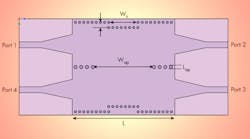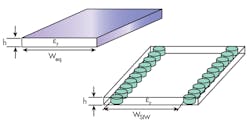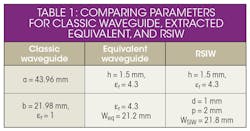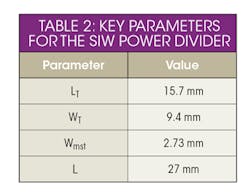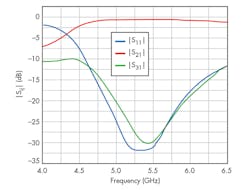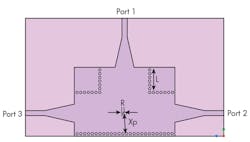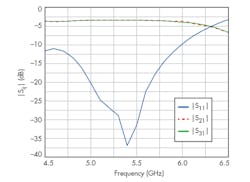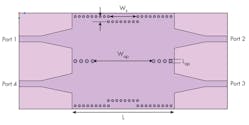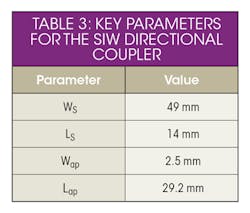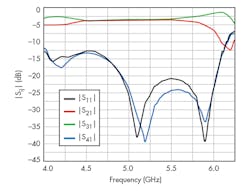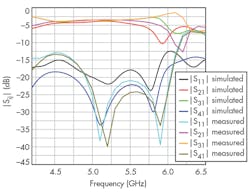This file type includes high-resolution graphics and schematics when applicable.
Substrate integrated waveguide (SIW) is a high-frequency transmission line that can provide excellent high-frequency performance on low-dielectric-constant substrate materials. To demonstrate the effectiveness of the technology, rectangular SIW (RSIW) was used to design and fabricate a SIW power divider, circulator, and coupler for use at frequencies from 4.0 to 6.5 GHz. In SIW, these components are readily implemented as planar circuits, with measured results of prototype circuits agreeing closely with computer simulations.
RSIW technology is usable through millimeter-wave frequencies and can readily be integrated with other planar circuits and transmission-line technologies. Compared to conventional waveguide technology at higher frequencies, RSIW can be used to fabricate a wide range of components with conventional printed-circuit-board (PCB) materials and processes to significantly reduce costs for many applications.1
RSIW Components
In exploring the capabilities of RSIW technology, a number of components were modeled with High-Frequency Structure Simulator (HFSS) three-dimensional (3D) electromagnetic (EM) simulation software from ANSYS. They were then fabricated to compare measured and simulated performance. The results match quite closely in the frequency band of interest from 4.0 to 6.5 GHz.
RSIW transmission line is essentially a type of rectangular dielectric-filled waveguide that is fabricated on a planar dielectric substrate. It incorporates arrays of conductive metal via holes to realize bilateral edge walls that enable transverse-electromagnetic (TE) propagation in all different TEn0 modes. Integrated transitions can be formed on an RSIW substrate for connection to other high-frequency planar structures, such as those formed with microstrip transmission lines.
RSIW components are covered by metal surfaces on both sides of the substrate, which contributes to low insertion loss, low radiation loss, and insensitivity to outside interference.1,2 The electrical behavior of RSIW (Fig. 1) is similar to that of a conventional rectangular waveguide filled with dielectric of width Weq.3
The experimental RSIW 4.0- to 6.5-GHz components employed the design parameters listed in Table 1 in comparison to conventional waveguide (Fig. 2). The via-hole dimensions were obtained from closed-form expressions described in refs. 1 and 2.
The ANSYS HFSS EM simulation software4 was used for EM field analysis of the RSIW transmission lines and the different component structures. The software made it possible to show the similarity of the EM field distribution of the TE10 propagation mode in the RSIW circuits and conventional waveguide technology applied to the same components and frequencies. To provide an interface to measurement equipment for analysis, tapers from RSIW to microstrip were designed, with parameters listed in Table 2.6
Simulation Results
The three components designed for evaluating RSIW technology were a circulator, power divider, and a coupler, all for operation from 4.0 to 6.5 GHz. The circulator was designed based on guidelines presented in refs. 2-5 (Fig. 3). As Fig. 4 shows, for more than 26.78% of the frequency band, the return loss (S11) is better than 15 dB while the maximum insertion loss (S21) is in the range of 0.54 dB. The isolation between ports (S31) is 30.16 dB.
The parameters listed in Tables 1 and 2 were also applied to the design and fabrication of an RSIW power divider, based on guidance from refs. 2-5 (Fig. 5). As shown in Fig. 6, the return loss (S11) is better than 15 dB between 4.86 and 5.78 GHz, or for more than 17.3% of the total bandwidth. The values of transmission coefficients S21 and S31 fluctuate between 3.38 and 3.67 dB across the frequency range, although these are acceptable values for a power divider for these two parameters.
The RSIW directional coupler (Fig. 7) was designed and simulated with ANSYS HFSS according to the parameters listed in Table 3 for use from 4.0 to 6.5 GHz and evaluated in terms of return loss, isolation, and bandwidth.1-5 As Fig. 8 shows, simulated results predict reflection (S11) and isolation (S41) levels of better than 15 dB for more than 25% of the total bandwidth, with insertion loss (S21) and coupling (S31) both on the order of 3.41 dB.
Prototype Validation
To validate the RSIW technology and the predicted performance levels provided by the EM simulation software, prototypes of the RSIW power divider and directional coupler were fabricated at ECS-Lab EA 3649, ENSEA. The prototype components were characterized using a commercial microwave vector network analyzer (VNA), model E5071C from Agilent Technologies (now Keysight Technologies), with a frequency range of 100 kHz to 8.5 GHz.
Figures 9 and 10 compare the simulated performance with the measured results for the RSIW power divider and directional coupler, respectively. In reviewing the performance of the power divider, the return loss (S11) is better than 15 dB for a 16% segment of bandwidth from 4.98 to 5.849 GHz. For the S21 and S31 parameters, the value is about 3.32 dB between 5.0 and 5.74 GHz. This equates to a relative bandwidth of about 14% of the total measured bandwidth, if amplitude flatness of ±0.3 dB is a qualifying characteristic. This is quite acceptable for such a power divider.
The measured results for the RSIW directional coupler show return loss (S11) of better than 15 dB between 4.739 and 5.500 GHz. This equates to more than 15% of the total bandwidth. The isolation between ports (S41) is on the order of 33.71 dB at 5.10 GHz. The insertion loss (S21) and the coupling (S31) are around 3.41 dB between 4.5 and 5.5 GHz, a 1-GHz range that represents 20% of the total bandwidth.
All in all, the measurements show some differences with the predictions provided by the computer simulations. In general, though, the simulated and measured S-parameters are in fairly good agreement for the two components.
The differences between measured and simulated data may stem from a number of factors, assuming that a simulation can only be as good as the input data used in the simulation. For example, some of the differences in the measured and simulated results may result from substrate conductor losses (or even dielectric losses) that were not included in the simulation. Other factors include an assumed loss tangent that was applied at 10 GHz, which may not have been applied at the lower frequencies of this experiment. In addition, the VNA may not have been properly calibrated, or the calibration may not have been up to date.
To minimize the through and reflected losses in passive components, such as the RSIW power divider and directional coupler, especially with the transitions made to microstrip to facilitate the VNA measurements, the impedance matching must be optimized. In the test setup, the impedance matching must be optimized between the SMA test connector and the directional coupler’s microstrip transmission lines. In addition, the taper from the microstrip transmission line is often as reflective as the RSIW component and its own transmission lines, and can significantly degrade the VNA measurement results.
Summary
In conclusion, the use of HFSS EM simulation software made it possible to design practical RSIW circuits such as the circulator, power divider, and directional coupler designed for 4.0 to 6.5 GHz. Measurements were made on two of the RSIW circuits, the power divider and the directional coupler. The experimental results compare well with the simulations and show the validity of this transmission-line technology for designing and constructing high-density microwave integrated circuits (MICs) for microwave and millimeter-wave frequencies.
By refining the measurement approaches and proper calibrating the test equipment, it may be possible to achieve an even closer match of simulated and measured results in the future. This will help further refine the understanding of how RSIW transmission-line technology can be used to achieve higher performance levels at microwave frequencies.
Dr. Bouchra Rahali is a Researcher at STIC Laboratory,University of Tlemcen, Tlemcen 13000, Algeria; E-mail: [email protected]
Mohammed Feham is a Professor at STIC Laboratory,University of Tlemcen, Tlemcen 13000, Algeria; E-mail: [email protected]
Achour Ouslimani, is a Professor at ENSEA, ECS Laboratory EA 3649, Cergy Pontoise, France; E-mail: [email protected]
Abed-Elhak Kasberi is a Researcher at ENSEA, ECS Laboratory EA 3649, Cergy Pontoise, France; E-mail: [email protected]
Junwu Tao, is a Professor at Laplace Laboratory, INP-ENSEEIHT Toulouse, France; E-mail: [email protected]
References:
1. Bouchra Rahali, “Contribution à la Modélisation Electromagnétique des structures Complexes Hyperfréquences en Technologie SIW,”doctoral thesis, Département de Génie Electrique et Electronique, Faculté de Technologie, Université Abou Bekr Belkaid de Tlemcen,Algeria, May 2013.
2. Bouchra Rahali and Mohammed Feham, “Coupler, Power Divider, and Circulator in V-Band Substrate Integrated Waveguide Technology,” IJCSA International Journal on Computational Sciences & Applications, Vol.3, No.6, December 2013.
3. Bouchra Rahali and Mohammed Feham, “Design of K-Band Substrate Integrated Waveguide Coupler, Circulator, and Power Divider,” International Journal of Information and Electronics Engineering, Vol. 4, No. 1, January 2014.
4. Bouchra Rahali and Mohammed Feham, “Substrate Integrated Waveguide Power Divider, Circulator, and Coupler in 10-15-GHz Band,” International Journal of Information Sciences and Techniques, Vol. 4, No. 1/2, March 2014, ISSN (Online):2249-1139.
5. Bouchra Rahali, Mohammed Feham, and Junwu Tao, “Analysis of S-Band Substrate Integrated Waveguide Power Divider, Circulator, and Coupler,” International Journal of Computer Science, Engineering, and Applications, Vol. 4, No. 2, April 2014, ISSN (Online): 2230-9616.
6. Bouchra Rahali and Mohammed Feham, “Design of Ku-Band Substrate Integrated Waveguide Phase Shifter,” International Journal of Information and Electronics Engineering, Vol. 4, No. 3, May 2014, ISSN (Online): 2010-3719.
Looking for parts? Go to SourceESB.
